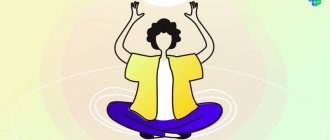An emotionally mature person feels the joy of life and knows how to create it in accordance with his aspirations and ideals, to reveal and realize his full potential. Emotional maturity is an adult position from which a person stops blaming external circumstances or other people for his own failures. How to achieve emotional maturity?
An emotionally mature person fully accepts responsibility for everything that happens to him, thereby gaining the opportunity to manage himself and his life.
Knowing yourself, your reactions to external events, the ability to describe your feelings and emotions, as well as awareness of why they arise and what is behind them are also qualities of an emotionally mature person. He can consciously and freely choose beautiful, positive and creative states instead of destructive negative emotions and automatic unconscious reactions. Able to feel and understand other people and build harmonious relationships with others.
This seems impossible to achieve. Yes, it’s not that easy, but anyone who wants it can do it.
Personality structure – multiple roles
During his life, a person learns, performs and develops many roles here and now. Based on this simple idea (Y.L. Moreno [3], A. Blatner [7]) that everyday behavior is the result of the dominance of one or more of many roles, we make a number of assumptions that, in our opinion, are self-evident:
- Each role has its own identity - a person’s perception, awareness and assessment of himself in different areas of life and in different relationships. 1.1. Identity is manifested in four relationships: “I” (in a role) - in relationships with myself, “You” - I (in a role) in relationships with a partner, “We” - I (in a role) in relationships with others/society..." , “Prime-We” – I (in the role) in a relationship with meaning and the world. 1.2. Each of these relationships plays out in four areas that become the place (locus nascendi) and manner (status nascendi) of action: body/sensory (physical sensation, appearance, motor and reaction patterns, etc.), contact/emotional (openness , ability to perceive value), achievement/logical (ability to recognize boundaries, make decisions, plan and carry out actions, etc.), meaning/future/fantasy (ability to see connections, understand meaning, consequences and feel involved).
- Each role has its own competence - the ability to observe, consciously assess the situation, create energy, make decisions and act constructively, understanding the meaning and consequences of actions. 2.1. The sources and ways of using energy (spontaneity) for any role are 4 basic needs/abilities that develop sequentially in the process of growing up: a. the need to feel and recognize the fact of one’s own existence/the ability to accept and feel support b. the need for love - experiences of unity, fullness of existence and self-worth / ability to love [1] openness, the ability to value oneself and another and feel value. V. the need for cognition, understanding/knowledge of oneself, others and expediency/ability to know, understand and respect oneself, another, to distinguish between one’s own and what belongs to others, to observe justice. d. the need/ability to understand meaning and belong to something larger 2.2. Energy is created in response to external and/or internal stimuli corresponding to four types of needs/abilities. Stimulation can be a) spontaneous, uncontrolled and b) conscious, induced. 2.3. The energy of each role is manifested in fantasy and in reality. The degree of correlation in internal and external implementation depends on the conditions for the emergence of the role and the degree of conscious mastery of it 2.4. New experience is acquired through the inversion of a new role or its aspects and such phenomena as imitation, identification, projection and transfer [3]. The universal development matrix consists of five successive stages and is laid down in the early stages of development. 2.5. Roles can conflict in any dimension of life (body, achievements, contacts, future) and in any area of identity (I, You, We, Great-We)
- Emotional maturity is characterized by awareness of the role (identification) and controllability of the role repertoire (competence), which allows one to actively choose a role appropriate to the situation and expand the range of role choices.
Mature emotional identity is manifested by uniform interest, sensitivity and activity in four areas of life (body, activity, contacts, future) and in four types of relationships (“I”; “YOU”; “WE”; “PRA-WE”). Let's look at the stages/areas of identity development:
Stage: primary matrix. Area: body/feelings. Identity: physical. Ability: conditioning, physical
The conditioning (physical) and two basic (loving and knowing) abilities are awakened to life by the basic spontaneity initiated at this stage
the dominant of survival (eat, grow, be born, breathe, digest, etc.). Energy is activated by changing conditions of life in the womb, birth, change of environment, first breath, first external contacts (breast, feeding, etc.).
At this stage, the basis of action and learning are sensations and reflexes2, which lay down the model of physical and psychological processes. This is pure training
“here-and-now” before the emergence of self-observation, assessment and management skills.
The passive need/ability of this stage - to live and fear - not to be, not to live, not to gain experience of life, to be absent from it, are balanced by the active intention/ability - to gain experience (to develop reflex connections that allow you to perceive space and time, form images);
Uncertainty regarding the main question of this stage according to V. Frankl [4]:
“I am here, but can I (as an integrated being) be here?” – may be the result of insufficient supportive physical stimulation, rejection, traumatic physical experience (violence, trauma) or other splitting and manifest as symptoms of fear and psychological manifestations of schizophrenia.
Having accepted his own existence, the child learns to accept the existence of others, preparing for the transition to the next stage. Thanks to this readiness, the energy manifested by anxiety is not excessive and can be successfully channeled into adaptation.
Stage: secondary matrix. Area: contacts/emotions. Identity: emotional. Ability: basic - love
As sensitivity develops and vision becomes clear, the child understands that his world and his mother’s world are not the same. This shock of transition from a universal to a differentiated universal (subjects and objects are separated) matrix of identity activates the energy of emotions as a way of overcoming the frustration of separation. The reality of being together is replaced by emotional unity. The absence at this stage of separation between objects of fantasy and reality allows you to activate energy not only by real, but also by virtual (fantasy) starters. Therefore, the “I” identity is internalized practically without filtering the attitude of parents and other loved ones, included in reality as a model of self-attitude.
The main tool for creating energy, gaining experience and learning at this stage are the not yet realized and unnamed emotions of primary relationships that model future patterns of relationships with “others”.
At this stage, the passive need/ability - to be loved and fear - not to be loved, to be lonely, not to experience the joy of unity / unification are compensated by the active intention / ability - to love;
An unclear or negative answer to the question: “Do I value my own life enough to enjoy it to its fullest by doing what I really want?” V. Frankl [4] considers the cause of borderline disorders and depression.
Accepting your worth allows you to appreciate the spontaneous expressions of others by demonstrating genuine interest and consideration. Such openness gives a sense of security, allows him to request and use external help when the differentiated universal world to which he has just adapted breaks into two.
Stage: tertiary matrix. Area: achievements/logic
Identity: Intentional/cultural. Ability: basic – cognize
2 for a better understanding of these mechanisms, we recommend turning to the work of L.M. Wecker “Psyche and reality. Unified theory of mental processes." (2000)
The next critical transition to the awareness of the difference between reality and fantasy, to the splitting of the hitherto indivisible inner world causes great anxiety and, at the same time, provides the opportunity to observe oneself, in one’s actions and feelings, to name and remember, and therefore to remember and integrate experience differences and feelings. There is an ability to understand cause-and-effect relationships and predict consequences, consciously direct one’s activity towards achieving something pleasant and/or avoiding something unpleasant, creating the energy of clear intentions
The main tools for creating energy at this stage are words, thoughts, images, associations and logic. The passive need/ability of this stage - to be understood and to receive the appropriate attitude and fear - of not being understood, to make mistakes, to suffer defeat and failure are neutralized by the active intention / ability - to understand others and treat them in accordance with this understanding;.
V. Frankl [4] calls this stage spiritual; we are more inclined to call it cultural, because it reflects the nature of group, cultural identity (a socially determined scale of values and assessments, aspirations and discipline of action). According to Frankl [4], the unanswered question: “Do I have the right to be who I am, is it good for others, what is my role and value in society?” – manifests as hysterical traits, possibly personality disorders and anxiety.
Self-respect, trust in your intentions and decisions makes it possible to respect and trust other people (with their different experience, vision, style of decision-making and action). This allows one to ask oneself about meaning, which is unlikely to be independently recognized, formulated, prioritized and resolved if social awareness, acceptance, self-respect and openness are absent.
Stage: maturity. Area: future/intuition. Identity: Spiritual. Ability: spontaneity developed into creativity (meaningful creation)
If all three abilities are adequately activated and developed, primary spontaneity is recognized and manifests as creativity: the ability to integrate, identify, understand relationships and dynamics, make decisions and energetically support their implementation. The energy of this stage is created by inspiration3, vision and the courage to trust them and make decisions based on them.
The passive need/ability to be defined (identified by someone/something larger, more significant than the individual himself), to be endowed with meaning and perspective, and the fear of meaninglessness are overcome at this stage by the active intention/ability to realize, understand and define the general and the particular ( own and others) meaning, to feel eternal/universal/spiritual loneliness.
Lack of answer to the question: “What will my life change in this world? What am I living for? What big and great am I connected with? – V. Frankl [4] associates with symptoms of dependence (as compensation for the lack of one’s own meaning with borrowed meaning).
The development of meaningfulness is facilitated by choice and actions based on values, participation in a group united by an idea, or a religious movement. Awareness of meaning brings the joy of harmony and unity with the world, the possibility of free, truly creative development in cooperation with others and the Universe itself.
Hypothetically, the acquisition of meaning can modulate the development of lower stages/abilities. There are known cases when primitively developed people and entire nations, finding meaning, changed their lives, showing the world inspiring
3 the term inspiration seems to give us some insight into human nature.
examples of unlocking the potential inherent in the very nature of a human being.
Internal and external stimulation in spontaneous and conscious warm-up
The clash of internal needs (nerve impulses, emotional needs, conscious desires, spontaneous and integrative/spiritual needs) collide with the conditions of the external world (environment and time, attitudes/feelings of other people, expectations of others, laws of the universe/values) leads to stress, mobilizing resources an organism that creates energy for adaptation.
When encountering reality, the child connects all events with his spontaneous actions with the logic: “I am the cause of everything.” The resulting action-result complex that satisfies basic needs will be perceived as desirable and vice versa. Thus, based on the ratio of the degree of satisfaction, a model of the scale of prioritization/evaluation/preference of actions/results is built. As it develops, the ability to consciously create energy based on decisions made increases (see Table 1).
Table 1. Examples of spontaneous and conscious energy creation
| SPONTANEOUS, UNCONTROLLED HEATING | ||||
| Body/sensory | Contacts/ emotional | Achievements/Logical | Future/fantasy | |
| Internal | Hunger | Striving for emotional unity | Striving to be understood | Unconscious expectations |
| External | Lack of food | Indifference | Not understanding | New situation |
| CONSCIOUSLY INDUCED WARMING | ||||
| Interior | Healthy eating idea | Active empathy | Awareness and clarification | Flexible planning |
| External | Diet and eating regimen | Friendship | Discussion | Role-playing game |
The created energy is realized depending on the ratio and awareness of internal and external stimuli in four main areas (Table 2):
1. Constructive model – compensation, adaptation, authenticity, equity/collaboration
The balance of normal internal stimulation with adequate external stimulation (encouragement/frustration) from the base environment leads to predominantly adequate and conscious self-motivated behavior consistent with the values and aspirations of the individual, aimed at the development of himself and his relationship with reality. This behavior is characterized by the ability to equally see, understand, appreciate and take into account external requirements and internal needs, and enter into mutually beneficial agreements.
2. Destructive model – overcompensation, dominance/competition
If insufficient external stimulation (reactions of encouragement/suppression from the base environment) is not able to balance normal or abnormally high internal stimulation, a tendency is formed to ignore external conditions, needs and expectations, leading to an overreaction in cases where reality does not
Table 2. Reactions and identity in the 4 main models
| Constructive | Destructive | Dependent | Scarce | |
| Reactions | ||||
| Body | tenderness, conscious freedom, plasticity, comfort | sympathetic reactions, allergies, asthma, restlessness, rapid speech, panic attacks | Parasympathetic reactions, chronic diseases, hysteria | fetigo, apathy, depression, autism, decreased metabolism and reactions |
| Achievements | proactivity, understanding, courtesy, openness, honesty | hyper-rationalization, suppressive activity, workaholism, actions for the sake of actions | reactive behavior, laziness, lack of independent initiative, irresponsibility | ambivalence, lack of intention, inaction |
| Contacts | Love, | Competition, | addiction, | indifference, |
| respect, | suppression | competition, | feeling | |
| cooperation | hyperreactivity, | manipulation, | emotional | |
| oh, encouragement. | explosiveness, | victimization | desolation | |
| aggression. | ||||
| Meaning | ethics, thoughtfulness and vision, creativity | compulsion, fixity, inconstancy, fanaticism | guilt, ambivalence, dramatic unhappiness | indifference, uselessness, doom, hopelessness |
| Identity | ||||
| I | “I am whole, valuable, consciously active and organic in the developing world” | “I am a master who must prove and maintain my integrity and worth in spite of this world by understanding and conquering it.” | “I am a victim of the world, entirely dependent on providence, surviving and justifying » | ignoring one's interests and/or denying their significance |
| You | own interests are taken into account equally with the interests of the partner | The interests of the partner are ignored and suppressed | their interests are ignored in favor of the partner, and responsibility is transferred to him | ignoring and/or denying the interests of the partner and the significance of the partnership |
| We | Group interests influence and can determine decisions | – group interests are ignored or viewed as competitive | the interests and assessments of the group are preferred to one’s own interests and judgments | ignoring one's own and public interests |
| Forefathers | A conscious system of values and meaningfulness determines all actions. | Short-term desires are preferred over long-term prospects | uncertainty in one’s own values is compensated by fanatical adherence to other people’s meanings | denial of the meaning and purposefulness of one’s existence and reality |
meets expectations. Such little-conscious manifestations are charged more with the energy of internal conflicts than with the real relationship between the individual and reality. In relationships, this leads to WIN-LOSE agreements.
3. Dependent/passive model – hypocompensation/competition
Excessive external stimulation (encouragement/suppression) from the base environment suppresses spontaneity, which leads to capitulation, feeling like a victim, dependent (on highly charged external relationships/conflicts)
/reactive behavior, building relationships of the “Lose-Win” type.
4. Deficit model – exhaustion, decompensation
A deficiency of intentions and mentality can be caused by 1. a physical disorder of internal stimulation and reflection; 2. depletion of spontaneity under the influence of insufficient external stimulation (encouragement/suppression) from the base environment, regular ambivalent and/or frustrating reactions/stimuli; 3)
“paralysis” of spontaneity under the influence of a shocking event/series of events. In this case, a person cannot recognize, understand, value and realize either his own or others’ interests, forming “Lose-Lose” agreements.
Ability to love
Opening up to love, whether romantic, platonic, or familial, is an act of courage. Making yourself vulnerable to both rejection and reciprocation is a sure sign of maturity. This is why teenagers often close themselves off to love. They are afraid of losing or being rejected. When most people reach adulthood, they will suffer countless times.
Only an emotionally mature person will be able to accept these rejections and pains as reality and continue to open up and invite intimacy and love into their lives.
Basic abilities and needs
Nossrat Pezeshkian [1] describes two basic abilities: to know and to love. It is obvious that they manifest themselves in the material world only through physicality with all its constitutional capabilities and limitations. Thus the life of the body
can and should be considered as a conditioning ability. In addition, we highlight spontaneity as an integrative (see below) ability.
Dissatisfaction with each of these abilities can lead to a certain degree of disadaptation.
Each ability is modeled by physical, chemical, biological and social conditions and develops into many physical (the nature of neurochemical processes, metabolism, motor patterns, physical development, etc.), emotional (love, tenderness, patience, sense of time, etc.). ), cognitive (diligence, accuracy, integrity, punctuality, etc.) and creative (meaningfulness, creativity, etc.) relevant abilities.
Development Matrix
The acquisition of new roles/skills is determined by the universal development matrix laid down in the early stages of development. Awareness and targeted use of this staged process was proposed by N. Pezeshkian [1] and allows for therapy, conscious development of oneself, relationships with a partner, social environment and fantasy/spirituality. This matrix consists of the following five stages:
- Observation is based on the ability to experience internal and external experiences as part of one's life. This ability originates in the infant's universal identity and is described by Moreno as the “stage of the other.” Conscious use of this stage presupposes the ability to cognitively master/aware and regulate one’s behavior in various situations and areas of one’s life.
- Inventory/understanding – the stage of focusing attention on another. Assumes and develops the ability to determine the content, history, dynamics and possibilities of life situations. Provided by analytical and logical resources of such abilities as justice, accuracy, order, openness, the ability to see the content of the conflict behind emotional manifestations.
- Situational reward/acceptance/motivation - the stage of exalting another part of the experience, overlooking everything else, including oneself, involves the ability to trust and find resources, and create conditions for their use through support and a combination of necessary ways of motivating oneself and others.
- Verbalization/decision/action - the stage of actively placing oneself in the place of another and testing the role of new experience. Ability to take responsibility for achieving change. Openness and honesty, patience and courtesy in conflict resolution, a balance of openness and conscious responsibility for the manifestation of emotional reactions. Ability to make decisions.
- Expanding goals, perspective - interaction in a new role with someone else, the ability to see a goal, predict results
Introduction
The concepts “Emotional maturity/intelligence/competence/education” are widely used to denote a number of motivational, communicative, empathic and behavioral abilities, regarded by society and inevitably culturally colored as success. Alas, none of the definitions available to us is justified within the framework of any theory of personality.
The first mentions of “social intelligence” (Robert Thorndike, David Wechsler [4]) appeared in the late 30s of the twentieth century; in 1943, Wechsler [5] suggested that success is determined primarily not by cognitive abilities. Truax and Carkhuff (1967) [5] established three scales of therapist effectiveness: (1) positive regard for the patient, (2) accurate empathy, and (3) congruence. Richard E. Boyatzis et al. (1977 – 1981) [5] described 8 scales: belief in the ability to change, effectiveness, comprehension skills, desire for personal growth, ego maturity, empathy, use of resources and authenticity. In the early 90s, Mayer and Salovey [5] defined “emotional competence”, Daniel Goleman [8;9] identified “emotional abilities”: self-understanding (self-awareness), recognition of one’s own emotions and their consequences, accurate self-esteem, self-esteem, self-management, self-control , trust, awareness, adaptability, achievement orientation, initiative, understanding others, empathy, organizational understanding, service orientation, social skills, developing others, leadership, influence, communication, catalyzing, conflict management, building connections, nurturing instrumental relationships, work teamwork and collaboration.
The concept of emotional maturity we proposed in 2002 has been significantly refined and tested in numerous studies, publications and debates. The results of this work are offered to your attention and discussion.
Openness
Nowadays they talk a lot about being open and ready for anything. However, this is a trait that few actually possess. Because true open-mindedness comes down to one thing: the willingness to admit that you are wrong.
Maturity breaks down mental barriers and opens up a sense of liberalism in a person. You no longer divide things into black and white, right and wrong. Your mind is open to many ideas and opinions. You do not judge those who think differently or choose to live differently from you.
You also allow your beliefs to soften to allow for the possibility that you may be wrong at times. You don't value facts as highly, but instead realize that there are many unknowns in the world.
Signs
Throughout its existence, a person is constantly changing due to the natural process of development or degradation. In some people this process is expressed more clearly, in others it is hidden.
The path to emotional maturity is often not easy; some individuals never achieve it, remaining infantile or emotionally immature individuals.
Individuals who are immature in the emotional sphere are characterized by uncertainty, a desire for self-affirmation at the expense of outsiders, and a tendency toward rudeness, envy, and condemnation. They are addicted to harmful weaknesses (alcohol, drugs). Due to dissatisfaction with their own existence, they try to console themselves by immersing themselves in the easily accessible temptations around them.
The emotional maturity of a person is characterized by the following characteristics:
– flexibility (the ability to adequately adapt to unique circumstances, events, situations);
– responsibility (a mature individual accepts responsibility for his own existence, he realizes that momentary circumstances are a consequence of the decisions he has made, he does not blame the environment if a failure occurs);
– the desire for self-development (solving problems of the future forces people to develop today, a mature personality feels the need to educate itself by receiving new information);
– search for alternative opinions (after all, a mature individual realizes that any activity, skill, process can be improved, so he willingly looks for other opinions, considers the views of those around him and happily follows them if he understands that the proposed path is more effective or less expensive);
– impartiality (disagreement with the views of others is not a reason to criticize them, since everyone has the right to have their own beliefs);
– stability (a mature subject realizes that there will always be disappointments, failures, problems and unsolved tasks will appear, so failure today does not unsettle him for a week, but allows him to outline further steps in order to normalize the situation);
– balanced behavior (naturally, it is impossible to remain calm and equanimous all the time, but in 80% of cases it is quite possible);
– realistic optimism (mature individuals are not prone to self-deception, they realize that success is due to patience and effort, and all this understanding is supported by adequate optimism);
– openness (it is easy to interact with such individuals, people feel comfortable in their presence);
– faith in one’s own personality;
– humor (mature individuals do not take themselves too seriously; they are able to sincerely laugh at themselves with their comrades or colleagues).
Every person has a different level of emotional maturity. This indicator is something that should be worked on, constantly improving it.
Self-control
Once you have established a strong sense of self-awareness, you will be in a better position to exercise some degree of self-control. You can identify the urges that accumulate in your mind. You can resist the temptation to act on them.
This, for example, can be the difference between being angry and calm when someone does something you don't like. A mature person is better equipped to exercise restraint towards things that may be detrimental to his short- or long-term well-being. They can overcome some of the most self-destructive behaviors by recognizing them for what they are.
What makes an emotionally mature person?
1. Awareness, recognition of his leading role in everything that happens in his life, in other words - responsibility. Such a person controls his reality, he is aware of one hundred percent involvement in everything that happens to him. “God has no other hands but yours.” This phrase very accurately reflects the principle of responsibility.
Responsibility gives an adult man strength, freedom, helps him gain “invisible wings”, because he controls his own life, and most importantly, he likes it. A person is free to choose his thoughts, words, actions, intentions, goals. The combination of these elements creates one or another life scenario.
God has no other hands but yours
2. Knowing yourself, your reactions, as well as the ability to identify and accept your emotions, analyze the reasons that cause them, the ability to correct your states, directing them in a creative direction.
3. The ability to build environmentally friendly relationships not only with oneself, but also with the outside world. Empathy, sympathy, respect, acceptance, the ability to hear another person and develop through him are important here. After all, it is precisely this position that is winning and gives us wisdom. If we perceive every person as a teacher, then this opens up truly tremendous opportunities for us.
4. Gratitude. Of course, we all know how important and valuable it is to express gratitude. When something joyful happens, something that gives us positivity from the first seconds, it’s quite simple and pleasant to do. But I would especially note the ability to appreciate and give thanks for those episodes and life situations that seem, at first glance, to cause pain and disappointment. Openness and trust in the world, the conviction that everything happens for a reason, everything has its own meaning and good for us. It may be veiled and seem to us something negative, but this is only because we sometimes cannot immediately see the whole picture.
Build and defend boundaries
Personal boundaries are an imaginary line that separates us from others physically and emotionally; it shows where we end and another begins, how we can and cannot be treated. Good boundaries help reduce stress and protect yourself and your mental and physical integrity.
But setting, let alone maintaining, boundaries is very difficult, especially when it comes to relationships with loved ones. If you are used to pleasing everyone, then realizing that refusal will offend or disappoint them is especially painful. But it’s worth it, because boundaries give us back a sense of security, thanks to them we remain ourselves.
Bibliography:
- Pezeshkian N. Psychotherapy of everyday life: training in fostering partnership and self-help: trans. with him. – M.: Medicine, 1995. – 336 p.
- Pezeshkian H. Fundamentals of positive psychotherapy. – Arkhangelsk: Publishing House AGMI, 1993. – 116 p.
- Moreno Ya.L. Psychodrama: Trans. from English – M.: Eksmo-Press, 2001. – 522 p.
- Guide to Clinical Child and Adolescent Psychiatry / ed. Kenneth S. Robinson: trans. from English – M.: Medicine, 1999 – 488 p.
- Frolov P. Some aspects of the emotional competence of a psychotherapist // Positum. – 2002. – No. 3. – P. 26-40
- Hatcher William. Scientific proof of the existence of God: trans. from English – Kyiv, 1992.
- Adam Blatner, Role Dynamics: an Integrative Approach to Psychology and User-Friendly Language – https://www.blatner.com/adam/level2/roletheory.htm, 2004
- Cary Cherniss and Daniel Goleman “An EI-Based Theory of Performance” From the book “The Emotionally Intelligent Workplace” – https://www.eiconsortium.org/research/ei_theory_performance.htm
- Boyartzis, R. E. Goleman, D., & Rhee, K. (1999). Clustering Competence in Emotional Intelligence: Insights from the Emotional Competence Invenotry (ECI) – https://www.eiconsortium.org/research/eci_clsters.htm
- Remmers A. Five Capacities of the Psychotherapist // The First World Conference of Positive Psychotherapy. – Wiesbaden, Germany, 1997. – P. 211-214.
What determines the level of emotional maturity?
The level of emotional maturity depends on our life experiences. Each of us has it unique. However, even if the experience of two people is similar, each of them interprets and uses it in their own way, drawing their own conclusions.
Here it is worth noting a second no less significant indicator, namely the level of human intelligence. The more educated and intellectually developed he is, the better he learns lessons from everything he encounters. This concerns both the depth and transparency of his conclusions, on which he can rely in the future.











